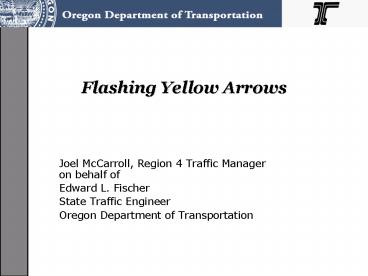Flashing Yellow Arrows - PowerPoint PPT Presentation
1 / 29
Title:
Flashing Yellow Arrows
Description:
NCHRP 493 (2003) Evaluation of Traffic Signal Displays for Protected/Permissive ... ODOT currently using Wapiti's W4IKS, W4HC11, or Voyage ... – PowerPoint PPT presentation
Number of Views:547
Avg rating:3.0/5.0
Title: Flashing Yellow Arrows
1
Flashing Yellow Arrows
- Joel McCarroll, Region 4 Traffic Manageron
behalf of - Edward L. Fischer
- State Traffic Engineer
- Oregon Department of Transportation
2
History of Flashing Yellow Arrows
- NCHRP 493 (2003) Evaluation of Traffic Signal
Displays for Protected/Permissive Left Turn
Control - FHWA Interim Approval for Optional Use of
Flashing Yellow Arrow for Permissive Left Turns
(March 2006) - NCHRP Web-Only Document 123 (2007) Evaluation of
FYA
3
Background
- Concerns with permissive circular green.
- Concern with circular green in doghouse.
- NCHRP 493 studied a wide variety of potential
displays. - Study included driver comprehension studies,
video conflict studies, and crash analyses.
4
Traditional Five-Section Doghouse
Courtesy of ODOT Photo and Video Services
5
Intersection with a FYA Head
Courtesy of ODOT Photo and Video Services
6
Flashing Yellow Arrow Head
Courtesy of ODOT Photo and Video Services
7
Comparison of Conversions
Before
After
8
FYA Head Configuration
- Separate signal face for the left turn signal
face. - Standard FYA head has four sections, all arrows.
- A three-section signal face with bimodal section
(green arrow and yellow flashing arrow) may be
used where impractical to use four-section head.
9
Meaning of Indications
- The steady red, yellow and green indications have
the usual meanings - Steady Red Arrow means stop
- Steady Green Arrow means protected turn
- Steady Yellow Arrow means the phase is changing
- The flashing yellow allows you to turn left when
oncoming traffic is clear (oncoming traffic has a
green light).
10
Summary of Research
- NCHRP 493 found that displays with exclusive
heads were found to offer the higher ratings in
terms of safety, operations, human factors, and
versatility. - The FYA was found to be more intuitive and had
fewer false positive reactions as compared to
the green ball. - NCHRP Web-Only Document 123 follow-up study
indicated significant safety benefits of the FYA.
11
Crash Reductions Found in NCHRP 123
- 12 intersections studied (3 in Oregon)
- Conversions from doghouses to FYAs
- Limited before/after data sets
- 74 percent reduction in left-turn related
crashes.
12
Benefits of FYA
- High level of understanding
- Best overall alternative to circular green
- More versatility in field operation
- Lead/lag and left turn re-service
- Time of day flexibility to run protected only,
PPLT, or permissive only.
13
FYA Animation
- Click to start animation
14
Implementation
- Oregon, Florida, and Maryland were among the
first few states with the FYA under the FHWA
Experimental status. - After FHWA Interim Approval, many other
jurisdictions across the country are now using
the FYA. - Draft MUTCD includes the FYA.
15
ODOT Evaluation of FYA
- Data available for 5 conversions from Doghouses
to FYA before 2008 - Annual average left-turn-related crashes reduced
from 1.1 crashes/yr/intersection to 0.35.
(Reduction of 67) - Calculated Benefit/Cost Ratio from crash
reductions is approximately 81 - More comparable crash data will be available
starting in 2010. (30 recent conversions from
Doghouse to FYA).
16
Operation of FYAs in Oregon
- Delay of Flashing Yellow Arrow allows opposing
traffic to get started while the FYA head remains
red. (3 seconds) - Minimum 3 second red indication during transition
from protected to permissive operation. - Seems to be some reluctance among signal timers
to run coordinated lead/lag operation.
17
FYA Operation
Courtesy of ODOT Photo and Video Services
18
FYAs in Oregon
- Flashing Yellow Arrow is the ODOT standard for
Protected/Permissive Phasing. - We are systematically replacing doghouses with
FYA. We are about 1/3 complete. - 49 installations on ODOT highways
- 183 installations on city streets and/or county
roads - 46 cities now have at least one FYA within their
city limits
19
46 Cities with FYA in Oregon
20
Installation Details
- All ODOT installations had engineered signal
plans prepared. - Evaluation of loading changes alleviated
structural concerns. - Requires one more conductor than protected-only
head. - FYA monitored through conflict monitor.
- All 30 conversions in 2008/2009 were completed by
ODOT electrical crews
21
Signal Timing
- ODOT currently using Wapitis W4IKS, W4HC11, or
Voyage - W4IKS requires command-box logic of approximately
200 lines of code. Necessitates use of laptop to
download timing to controller. - W4HC11 has new tables for FYA without command
box. - Voyage software for the 2070L controller runs the
FYA without command box.
22
Costs of Conversion
- 30 intersections were converted from doghouse
left turn heads to the FYA head. - Most conversions involved 2 doghouse heads
- Average cost was 9,100 per intersection
including - Site assessment and engineering
- Hardware
- Installation labor
- Temporary traffic control
23
Custom Bracket for Spanwire Installations
24
Custom Bracket for Spanwire Installations(Region
2 Electrical Crew Design)
25
Custom Bracket for Spanwire Installations
26
Other Issues
- Oregon has a few bi-modal heads.
- 20-7 Project to compare the approved 4 section
head with a three section bi-modal head. - Jackson County in southern Oregon has
experimental approval for FYAs that operate
differently from the interim approval.
27
Summary
- In Oregon, the FYA has proven to be
- Significant safety improvement over the doghouse
- Easily understood by drivers
- Versatile
- Easy to install, operate, maintain
- Popular in many jurisdictions
28
More Information
- Contact
- Ed Fischer
- (Ed.L.Fischer_at_odot.state.or.us)
- Or
- Gary Obery
- (Gary.R.Obery_at_odot.state.or.us)
29
Questions































